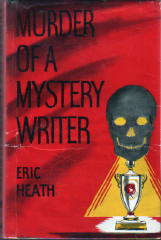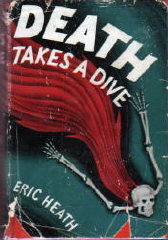Thu 28 Feb 2008
Archived Review: ERIC HEATH – Murder of a Mystery Writer.
Posted by Steve under Authors , Crime Fiction IV , Reviews1 Comment
ERIC HEATH – Murder of a Mystery Writer.Arcadia House, hardcover 1955. A rewritten version of Death Takes a Dive, Hillman-Curl, 1938.
Whenever you come across a book that is — how shall I phrase this? — not as good as it could have been, how overwhelming the temptation is to start quoting large portions of it just to prove the point. Only a consideration of space unwisely used keeps my resistance high.
Murder of a Mystery Writer begins with chapter one, as so many books do. Criminologist Dr. Wade Anthony, whose pet theory it is that motion pictures will soon be the crime investigator’s number one tool, takes his secretary-assistant Penny Lake along with him, hoping to find Mystery Lodge (about which more later) a quiet place of seclusion in which to write his latest book.
Instead, when upon arrival they find themselves snowed in, they also find themselves interlopers to a branch meeting of the Mystery Writers’ Guild that is running concurrently. The mystery writers are past experts at slugging away at each other with a continuous flow of insults, but one of the other main topics of discussion is the possibility of a perfect crime being committed. At length, one of the more obnoxious of the authors is done away with. Could this have been a trial run?
This may in fact sound pretty good, and without quoting, I can’t say that I’m conveying very well the fact that the first few chapters are pure, unadulterated corn. Mystery Lodge is a prime example of what some misguided entrepreneurs consider a topnotch tourist attraction. Bizarre is hardly the word for it. It’s filled with phony coffins, artificial corpses in the closets, snakes hanging from the chandeliers — all the brain child of the saturnine host, the greatest mystery reader in the world, Antrim Zarzour.
Heath has his heart in the right place, however, and I have to admit, it’s a valiant effort. The murder is committed at dinner, with a gunshot ringing out as the lights go off, whereupon the weapon immediately disappears. There are lots of suspects and mysterious servants, a dying message, a tuning pipe, and a trapdoor or two.
All very interesting, you might agree. But beyond the fact that Heath demonstrates no great skills as a writer, the fact remains that murder is not a game that has to be solved according only to the rules. If there was no such thing as mystery fiction, this story would be impossible — in more ways than (the obvious) one. [D]
[UPDATE] 02-28-08. In my first paragraph, I mentioned the restrictions I placed upon myself in refusing to quote or paraphrase long passages. But when Bill Pronzini provided me with the cover image that graces this review, he reminded me that:
“I not only have a copy in jacket (scan attached), I found it so atrocious when I read it back in the early 80s that I wrote a six-page dissection of its plot absurdities and accorded it Alternative Hall of Fame status in Gun in Cheek (Coward McCann, 1982). A classic!”
How could I resist? I didn’t quote from Eric Heath’s book back in 1979, but I am going to quote Bill today, almost 30 years later. These paragraphs describe what immediately followed the murder that was committed at dinner, as mentioned above:
Anthony proceeds to question everyone, without learning much. The mystery writers, meanwhile, argue over which of them is going to write up Lang’s murder in fictional form; each wants to do so and each under the title Murder of a Mystery Writer. Nobody pays much attention to the corpse.
Suspicion falls on the dwarf, Gargoyle, when Zarzour claims to have found the murder weapon in Gargoyle’s possession. (He also found a Maxim silencer, and that’s why nobody heard the shot that killed Lang.) The dwarf proclaims his innocence. He doesn’t know how the gun and silencer got into his coat pocket, he says, which is where he discovered them when he returned to his room after the shooting.
Anthony’s sharp questioning reveals that Gargoyle had once spilled a glass of water in Lang’s lap and Lang had cursed him for his clumsiness. Everyone thinks this is a very damning motive for murder. Cora is particularly pithy in her condemnation: “Does anybody know whether cretinism causes people to see better in the dark than normally built people?”
Dr. Anthony isn’t so sure of Gargoyle’s guilt, though. As he confides to Penny later, “I’m inclined to think that there is a much deeper psychological basis for this crime than a dwarf committing murder to avenge a personal insult.”
For the other five and a half pages, you’re going to have to read Gun in Cheek for yourself. (You’re going to have trouble reading Heath’s book itself, though, if you’re interested in primary sources. Nary a copy is offered by anybody online.)
And for those of you willing to investigate further, here is the complete entry for Eric Heath in Crime Fiction IV, by Allen J. Hubin:
HEATH, ERIC (1897?-1979?)
Death Takes a Dive (Hillman-Curl, 1938, hc) [Cornelius Clift, Jr.; Los Angeles, CA]
Murder in the Museum (Hillman-Curl, 1939, hc) [Cornelius Clift, Jr.; California]
Murder of a Mystery Writer (Arcadia, 1955, hc) [Wade Anthony; California] Rewritten version of Death Takes a Dive, q.v.
The Murder Pool (Arcadia, 1954, hc) [Wade Anthony; Los Angeles, CA]
[UPDATE] 03-05-08. Excerpted from an email sent me by Bill Pronzini:
[When Al says that] Murder of a Mystery Writer is a “rewrite†of Death Takes a Dive, it probably gives the wrong impression that the two books are more or less identical — a case of total self-plagiarism. Not so.
The latter uses the exact same plot devices as the former, but the setting in Dive is a Beverly Hills house party, and the characters, while similar in other ways, are Hollywood types (sans dwarf, rather than mystery writers. Also, Dive is narrated by a “glamorous hard-as-nails female detective†named Winnie Preston and the criminologist who solves the caper and earns Winnie’s undying love is called Copey.


July 18th, 2009 at 4:15 pm
[…] latter was previously reviewed here. The book was a rewrite of Heath’s own Death Takes a Dive (1938), the protagonists of which […]